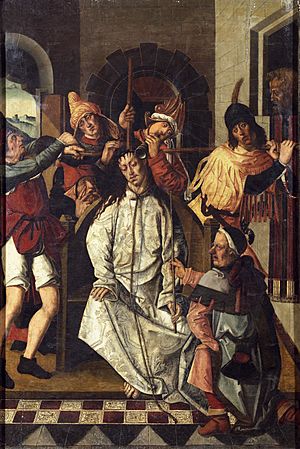Rodrigo de Osona facts for kids

Rodrigo de Osona (born around 1440, died around 1518) was an important Spanish painter during the Renaissance period. He is sometimes called Rodrigo de Osona the Elder to tell him apart from his son.
Contents
How He Started Painting
Rodrigo de Osona likely learned his painting skills in Italy. He might have studied in cities like Ferrara, Padua, and Venice. These cities were famous for their art at the time.
One of his first known works is a large painting for the altarpiece of the Calvary church of San Nicolas in Valencia. He signed this painting in 1476. Because of this signed work, experts have been able to figure out that he painted other pieces too. One famous painting attributed to him is the Pietà, which is now in the Museu de Belles Arts de València. He painted this between 1485 and 1490.
Working with His Son, Francisco
Rodrigo de Osona worked very closely with his son, Francisco de Osona, in their art studio in Valencia. Because they worked so closely, it can be hard to tell which paintings were done by the father and which by the son. Many artworks are simply credited to both of them.
Some art experts believe that Francisco was more open to new painting styles and ideas coming from Italy. However, Francisco died in 1514, which was before his father, Rodrigo, who died in 1518. This means Francisco was much younger when he passed away.
There is a painting called "The Epiphany" in London. It is signed by "The teacher's son Rodrigo," which refers to Francisco. This painting actually seems to show a more traditional style, similar to his father's earlier works.
His Artistic Style and Importance
Rodrigo de Osona is seen as one of the first artists to bring Renaissance art styles to Spanish painting. His work truly captured the feeling of the Italian Quattrocento (the 1400s).
However, he didn't just copy Italian art. He also used ideas from Flemish painting, which came from areas like modern-day Belgium and the Netherlands. Flemish art often showed strong feelings and less ideal beauty. Rodrigo's paintings focused on kindness and gentleness, which was important for religious art at the time.
His artworks show that he cared about making the natural backgrounds and buildings in his scenes look realistic. He was also very skilled at using oil paints. The combined work of Rodrigo and Francisco de Osona, along with another painter named Paolo de San Leocadio, helped create the foundation for classic Spanish painting.
See also
 In Spanish: Rodrigo de Osona para niños
In Spanish: Rodrigo de Osona para niños

